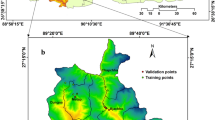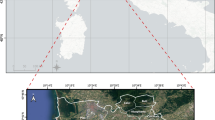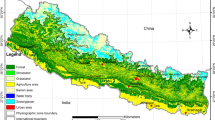Abstract
This study used deep learning to evaluate the ecological vulnerability of Chongqing, China, discuss the deep learning evaluations of ecological vulnerability, and generate vulnerability maps that support local ecological environment protection and governance decisions and provide reference for future studies. The information gain ratio was used to screen the influencing factors, selecting 16 factors that influence ecological vulnerability. Deep neural network (DNN) and convolutional neural network (CNN) methods were used for modeling, and two ecological vulnerability maps of the study area were generated. The results showed that the mean absolute error and root mean square error of the DNN and CNN models were relatively small, and the fitting accuracy was high. The area under the receiver operating characteristic curve of the CNN model was 0.926, which was better than that of the DNN model (0.888). Random forest was applied to calculate the importance of the influencing factors in the two models. Because the main factor was geological features, the relative ecological vulnerability was mainly affected by karst topography. Through the analysis of the ecological vulnerability map, the areas with higher vulnerability are the karst mountains of Dabashan, Wushan, and Qiyaoshan in the northeast and southeast, as well as the valley between mountains and cities in the center and west of the study area. According to the investigation of these areas, the primary ecological problems are low forest quality, structural irregularities caused by self-geological factors, severe desertification, and soil erosion. Human activity is also an important factor that causes ecological vulnerability in the study area. In conclusion, deep learning, particularly CNN models, can be used for ecological vulnerability assessments. The ecological vulnerability maps conformed to the basic cognition of field surveys and can provide references for other deep learning vulnerability studies. While the overall vulnerability of the study area is not high, ecological problems that lead to its vulnerability should be addressed by future ecological protection and management measures.











Similar content being viewed by others
Data availability
Most data generated or analyzed during this study are included in this published article. Some of them are available in the Table 1 of this paper.
References
Abdullah S, Barua D (2022) Combining Geographical Information System (GIS) and deep learning to monitor and predict vegetation vulnerability: an Empirical Study on Nijhum Dwip, Bangladesh. Ecol Eng 178. https://doi.org/10.1016/j.ecoleng.2022.106577
Berrouet L, Villegas-Palacio C, Botero V (2019) A social vulnerability index to changes in ecosystem services provision at local scale: a methodological approach. Environ Sci Policy 93:158–171. https://doi.org/10.1016/j.envsci.2018.12.011
Breiman L (2001) Random forests. Mach Learn 45:5–32. https://doi.org/10.1023/A:1010933404324
Chandra A, Gaganis P (2016) Deconstructing vulnerability and adaptation in a coastal river basin ecosystem: a participatory analysis of flood risk in Nadi, Fiji Islands. Clim Dev 8:256–269. https://doi.org/10.1080/17565529.2015.1016884
Chen WX (2022) A multi-scale assessment of ecosystem health based on the pressure-state-response framework: a case in the middle reaches of the Yangtze River Urban Agglomerations, China. Environ Sci Pollut Res 29:29202–29219. https://doi.org/10.1007/s11356-021-17768
Chen W, Shahabi H, Zhang S, Khosravi K, Shirzadi A, Chapi K, Pham BT, Zhang TY, Zhang LY, Chai HC, Ma JQ, Chen YT, Wang XJ, Li RW, Bin Ahmad B (2018) Landslide susceptibility modeling based on GIS and novel bagging-based kernel logistic regression. Appl Sci 8. https://doi.org/10.3390/app8122540
Chen JF, Li Q, Wang HM, Deng MH (2020) A deep learning ensemble approach based on random forest and radial basis function neural network for risk evaluation of regional flood disaster: a case study of the Yangtze River Delta, China. Int J Environ Res Public Health 17. https://doi.org/10.3390/ijerph17010049
Di Marco M, Ferrier S, Harwood TD, Hoskins AJ, Watson JEM (2019) Wilderness areas halve the extinction risk of terrestrial biodiversity. Nature 573:582. https://doi.org/10.1038/s41586-019-1567-7
Dinerstein E, Vynne C, Sala E, Joshi AR, Fernando S, Lovejoy TE, Mayorga J, Olson D, Asner GP, Baillie JEM, Burgess ND, Burkart K, Noss RF, Zhang YP, Baccini A, Birch T, Hahn N, Joppa LN, Wikramanayake E (2019) A global deal for nature: guiding principles, milestones, and targets. Sci Adv 5. https://doi.org/10.1126/sciadv.aaw2869
Ding AZ, Zhang QY, Zhou XM, Dai BC, IEEE (2016) Automatic recognition of landslide based on CNN and texture change detection. 2016 31ST YOUTH Acad. Annu. Conf. CHINESE Assoc. Autom. 444–448. https://ieeexplore.ieee.org/document/7804935/. Accessed 11-13-2016
Dodangeh E, Choubin B, Eigdir AN, Nabipour N, Panahi M, Shamshirband S, Mosavi A (2020) Integrated deep learning methods with resampling algorithms for flood susceptibility prediction. Sci Total Environ 705. https://doi.org/10.1016/j.scitotenv.2019.135983
Eakin H, Luers AL (2006) Assessing the vulnerability of social-environmental systems. Annu Rev Environ Resour 31:365–394. https://doi.org/10.1146/annurev.energy.30.050504.144352
Fan JL, Wu LF, Zhang FC, Cai HJ, Zeng WZ, Wang XK, Zou HY (2019) Empirical and deep learning models for predicting daily global solar radiation from sunshine duration: a review and case study in China. Renew Sustain Energy Rev 100:186–212. https://doi.org/10.1016/j.rser.2018.10.018
Ferreira JG, Bricker SB, Simas TC (2007) Application and sensitivity testing of a eutrophication assessment method on coastal systems in the United States and European Union. J Environ Manage 82:433–445. https://doi.org/10.1016/j.jenvman.2006.01.003
Gao JB, Jiao KW, Wu SH (2018) Quantitative assessment of ecosystem vulnerability to climate change: methodology and application in China. Environ Res Lett 13. https://doi.org/10.1088/1748-9326/aadd2e
Gonzalez P, Neilson RP, Lenihan JM, Drapek RJ (2010) Global patterns in the vulnerability of ecosystems to vegetation shifts due to climate change. Glob Ecol Biogeogr 19:755–768. https://doi.org/10.1111/j.1466-8238.2010.00558.x
Gu JX, Wang ZH, Kuen J, Ma LY, Shahroudy A, Shuai B, Liu T, Wang XX, Wang G, Cai JF, Chen T (2018) Recent advances in convolutional neural networks. Pattern Recognit 77:354–377. https://doi.org/10.1016/j.patcog.2017.10.013
Han J, Park S, Kim S, Son S, Lee S, Kim J (2019) Performance of logistic regression and support vector machines for seismic vulnerability assessment and mapping: a case study of the 12 September 2016 ML5.8 Gyeongju Earthquake, South Korea. Sustainability 11. https://doi.org/10.3390/su11247038
Hosseinalizadeh M, Kariminejad N, Chen W, Pourghasemi HR, Alinejad M, Behbahani AM, Tiefenbacher JP (2019) Spatial modelling of gully headcuts using UAV data and four best-first decision classifier ensembles (BFTree, Bag-BFTree, RS-BFTree, and RF-BFTree). Geomorphology 329:184–193. https://doi.org/10.1016/j.geomorph.2019.01.006
IPCC (2022) Climate Change 2022: Impacts, Adaptation and Vulnerability. The Working Group II contribution to the IPCC Sixth Assessment Report. https://www.ipcc.ch/report/ar6/wg2/
Iwata K, Ikeda K, Sakai H (2004) A new criterion using information gain for action selection strategy in reinforcement learning. IEEE Trans Neural Netw 15:792–799. https://doi.org/10.1109/TNN.2004.828760
Jiang L, Huang XX, Wang FT, Liu YC, An PL (2018) Method for evaluating ecological vulnerability under climate change based on remote sensing: a case study. Ecol Indic 85:479–486. https://doi.org/10.1016/j.ecolind.2017.10.044
Jinyin W, Yunqiang C, Pengfei C (2021) Annual soil erosion modulus 1 km raster dataset for mountainous regions of Southwest China. Electronic J Global Change Data Repository. https://doi.org/10.3974/geodb.2021.04.04.v1
Kumar M, Savita SH, Pandey R, Singh MP, Ravindranath NH, Kalra N (2019) Assessing vulnerability of forest ecosystem in the Indian Western Himalayan region using trends of net primary productivity. Biodivers Conserv 28:2163–2182. https://doi.org/10.1007/s10531-018-1663-2
LeCun Y, Boser B, Denker JS, Henderson D, Howard RE, Hubbard W, Jackel LD (1989) Backpropagation applied to handwritten zip code recognition. Neural Comput 1:541–551. https://doi.org/10.1162/neco.1989.1.4.541
Lecun Y, Bottou L, Bengio Y, Haffner P (1998) Gradient-based learning applied to document recognition. Proc IEEE 86:2278–2324. https://doi.org/10.1109/5.726791
Liu L, Silva EA, Wu CY, Wang H (2017) A deep learning-based method for the large-scale evaluation of the qualities of the urban environment. Comput Environ Urban Syst 65:113–125. https://doi.org/10.1016/j.compenvurbsys.2017.06.003
Lombardo L, Bakka H, Tanyas H, van Westen C, Mai PM, Huser R (2019) Geostatistical modeling to capture seismic-shaking patterns from earthquake-induced landslides. J Geophys Res Surf 124:1958–1980. https://doi.org/10.1029/2019JF005056
Milton GR, Prentice RC, Finlayson CM (2016) Wetlands of the World. The Wetland Book. Springer, Dordrecht. https://doi.org/10.1007/978-94-007-6173-5_182-1
Mosavi MR, Khishe M, Ghamgosar A (2016) Classification of sonar data set using neural network trained by gray wolf optimization. Neural Netw World 26:393–415. https://doi.org/10.14311/NNW.2016.26.023
Newton A, Weichselgartner J (2014) Hotspots of coastal vulnerability: a DPSIR analysis to find societal pathways and responses. Estuar Coast Shelf Sci 140:123–133. https://doi.org/10.1016/j.ecss.2013.10.010
Nilsson C, Grelsson G (1995) The fragility of ecosystems: a review. J Appl Ecol 32:677–692. https://doi.org/10.2307/2404808
Nohani E, Moharrami M, Sharafi S, Khosravi K, Pradhan B, Pham BT, Lee S, Melesse AM (2019) Landslide susceptibility mapping using different GIS-based bivariate models. Water 11. https://doi.org/10.3390/w11071402
Pal S, Debanshi S (2021) Deep learning models for wetland habitat vulnerability in mature Ganges delta. Environ Sci Pollut Res 28:19121–19146. https://doi.org/10.1007/s11356-020-11413-8
Pan ZZ, Gao GY, Fu BJ (2022) Spatiotemporal changes and driving forces of ecosystem vulnerability in the Yangtze River Basin, China: quantification using habitat-structure-function framework. Sci Total Environ 835. https://doi.org/10.1016/j.scitotenv.2022.155494
Pimm SL, Jenkins CN, Abell R, Brooks TM, Gittleman JL, Joppa LN, Raven PH, Roberts CM, Sexton JO (2014) The biodiversity of species and their rates of extinction, distribution, and protection. Science (80- ) 344:987-+. https://doi.org/10.1126/science.1246752
Pourghasemi HR, Kerle N (2016) Random forests and evidential belief function-based landslide susceptibility assessment in Western Mazandaran Province, Iran. Environ Earth Sci 75. https://doi.org/10.1007/s12665-015-4950-1
Pradhan AMS, Dawadi A, Kim YT (2012) Use of different bivariate statistical landslide susceptibility methods: a case study of Khulekhani watershed, Nepal. J Nepal Geol Soc 44:1–12. https://doi.org/10.3126/jngs.v44i0.24483
Prasetyo LB, Setiawan Y, Condro AA, Kustiyo K, Putra EI, Hayati N, Wijayanto AK, Ramadhi A, Murdiyarso D (2022) Assessing Sumatran peat vulnerability to fire under various condition of ENSO phases using deep learning approaches. Forests 13. https://doi.org/10.3390/f13060828
Rahmati O, Tahmasebipour N, Haghizadeh A, Pourghasemi HR, Feizizadeh B (2017) Evaluating the influence of geo-environmental factors on gully erosion in a semi-arid region of Iran: an integrated framework. Sci Total Environ 579:913–927. https://doi.org/10.1016/j.scitotenv.2016.10.176
Raufirad V, Heidari Q, Hunter R, Ghorbani J (2018) Relationship between socioeconomic vulnerability and ecological sustainability: the case of Aran-V-Bidgol’s rangelands. Iran Ecol Indic 85:613–623. https://doi.org/10.1016/j.ecolind.2017.11.009
Reichenbach P, Rossi M, Malamud BD, Mihir M, Guzzetti F (2018) A review of statistically-based landslide susceptibility models. Earth-Science Rev 180:60–91. https://doi.org/10.1016/j.earscirev.2018.03.001
Rodriguez-Galiano VF, Ghimire B, Rogan J, Chica-Olmo M, Rigol-Sanchez JP (2012) An assessment of the effectiveness of a random forest classifier for land-cover classification. ISPRS J Photogramm Remote Sens 67:93–104. https://doi.org/10.1016/j.isprsjprs.2011.11.002
Rodriguez-Galiano V, Sanchez-Castillo M, Chica-Olmo M, Chica-Rivas M (2015) Deep learning predictive models for mineral prospectivity: an evaluation of neural networks, random forest, regression trees and support vector machines. Ore Geol Rev 71:804–818. https://doi.org/10.1016/j.oregeorev.2015.01.001
Saha S, Gogoi P, Gayen A, Paul GC (2021) Constructing the deep learning techniques based spatial drought vulnerability index in Karnataka state of India. J Clean Prod 314. https://doi.org/10.1016/j.jclepro.2021.128073
Sandeep P, Reddy GPO, Jegankumar R, Arun Kumar KC (2021) Modeling and assessment of land degradation vulnerability in semi-arid ecosystem of Southern India using temporal satellite data, AHP and GIS. Environ Model Assess 26(2):143–154. https://doi.org/10.1007/s10666-020-09739-1
Schroter D, Cramer W, Leemans R, Prentice IC, Araujo MB, Arnell NW, Bondeau A, Bugmann H, Carter TR, Gracia CA, de la Vega-Leinert AC, Erhard M, Ewert F, Glendining M, House JI, Kankaanpaa S, Klein RJT, Lavorel S, Lindner M, Metzger MJ, Meyer J, Mitchell TD, Reginster I, Rounsevell M, Sabate S, Sitch S, Smith B, Smith J, Smith P, Sykes MT, Thonicke K, Thuiller W, Tuck G, Zaehle S, Zierl B (2005) Ecosystem service supply and vulnerability to global change in Europe. Science (80) 310:1333–1337. https://doi.org/10.1126/science.1115233
Song GB, Chen Y, Tian MR, Lv SH, Zhang SS, Liu SL (2010) The ecological vulnerability evaluation in Southwestern Mountain Region of China based on GIS and AHP method. Int Conf Ecol Informatics Ecosyst Conserv 2:465–475 (ISEIS 2010)
Vakhshoori V, Pourghasemi HR, Zare M, Blaschke T (2019) Landslide susceptibility mapping using GIS-based data mining algorithms. Water 11. https://doi.org/10.3390/w11112292
Wang SJ, Liu QM, Zhang DF (2004) Karst rocky desertification in southwestern China: geomorphology, landuse, impact and rehabilitation. Land Degrad Dev 15(2):115–121. https://doi.org/10.1002/LDR.592
Wang YQ, Wu ZJ, Yan B, Li K, Huang F (2021b) Research on ecological environment impact assessment based on PSR and cloud theory in Dari county, source of the Yellow River. Water Supply 21:1050–1060. https://doi.org/10.2166/ws.2020.286
Wang Y, Hao LN, Zhao ML (2022) Variation of vegetation NDVI and its response to climatic factors and human activities in Chongqing from 2001 to 2018. Res Soil Water Conserv 28(05):222–229. https://doi.org/10.13869/j.cnki.rswc.2021.05.025. (in Chinese)
Wang F, Lu Y, Li J, Ni J (2021a) Evaluating environmentally sustainable development based on the PSR framework and variable weigh analytic hierarchy process. Int J Environ Res Public Health 18. https://doi.org/10.3390/ijerph18062836
Wiegand C, Kringer K, Geitner C, Rutzinger M (2013) Regolith structure analysis - a contribution to understanding the local occurrence of shallow landslides (Austrian Tyrol). Geomorphology 183:5–13. https://doi.org/10.1016/j.geomorph.2012.06.027
Woodley S, Bhola N, Maney C, Locke H (2019) Area-based conservation beyond 2020: a global survey of conservation scientists. Parks 19–30. https://doi.org/10.2305/IUCN.CH.2019.PARKS-25-2SW1.en
Xin W, Chun C (2022) Study on spatial-temporal evolution of ecosystem service value in Chongqing section of Yangtze River Basin based on ’ PLE Space’. J Chongqing Normal University (Natural Science) 39(03):128–140 (in Chinese)
Xu Y, Shen ZH, Ying LX, Ciais P, Liu HY, Piao SL, Wen C, Jiang YX (2016) The exposure, sensitivity and vulnerability of natural vegetation in China to climate thermal variability (1901–2013): an indicator-based approach. Ecol Indic 63:258–272. https://doi.org/10.1016/j.ecolind.2015.12.023
Xu K, Wang XP, Jiang C, Sun OJX (2020) Assessing the vulnerability of ecosystems to climate change based on climate exposure, vegetation stability and productivity. For Ecosyst 7. https://doi.org/10.1186/s40663-020-00239-y
Yang R, Cao Y, Hou SY, Peng QY, Wang XS, Wang FY, Tseng TH, Yu L, Carver S, Convery I, Zhao ZC, Shen XL, Li S, Zheng YM, Liu H, Gong P, Ma KP (2020) Cost-effective priorities for the expansion of global terrestrial protected areas: setting post-2020 global and national targets. Sci Adv 6. https://doi.org/10.1126/sciadv.abc3436
Yang J, Huang X (2021) The 30 m annual land cover dataset and its dynamics in China from 1990 to 2019. Earth Syst Sci Data 13(8):3907–3925
Yi YN, Zhang ZJ, Zhang WC, Jia HH, Zhang JQ (2020) Landslide susceptibility mapping using multiscale sampling strategy and convolutional neural network: a case study in Jiuzhaigou region. CATENA 195. https://doi.org/10.1016/j.catena.2020.104851
Yu RY, Liang LK, Su XY, Cheng JL (2020) A driver based framework for vulnerability assessment of the poverty stricken areas of Funiu Mountain, China. Ecol Indic 113. https://doi.org/10.1016/j.ecolind.2020.106209
Zhang LM, Xiao T, He J, Chen C (2019) Erosion-based analysis of breaching of Baige landslide dams on the Jinsha River, China, in 2018. Landslides 16:1965–1979. https://doi.org/10.1007/s10346-019-01247-y
Funding
This work was supported by National Natural Science Foundation of China (Grant No. 92055314), International Geosciences Program (Grant Numbers: IGCP741), China Geological Survey Project (Grant Numbers: DD20221776, DD20230706 and DD20230013), and Liu Baojun Academician Fund and the International Scientific Plan of the Qinghai-Xizang Plateau of Southwest Geological Science.
Author information
Authors and Affiliations
Contributions
All authors contributed to the study conception and design. Material preparation, data collection, and analysis were performed by Junyi Wu, Tong Li, Wenlong Gao, and Lu Shao. The first draft of the manuscript was written by Junyi Wu. The model of the manuscript was built by Junyi Wu. The main mythology of the manuscript was directed by Yuan Ouyang. The vulnerability division and analysis were performed by Junyi Wu, Hong Liu, Yuan Ouyang, Jinghua Zhang, and Yong Huang. And all authors commented on previous versions of the manuscript. All authors read and approved the final manuscript.
Corresponding author
Ethics declarations
Ethics approval and consent to participate
The study does not involve animal or human trials. So, there is no ethics approval and consent to participate statement required.
Consent for publication
The Author confirms (1) that the work described has not been published before (except in the form of an abstract or as part of a published lecture, review, or thesis); (2) that it is not under consideration for publication elsewhere; (3) that its publication has been approved by all co-authors, if any; (4) that its publication has been approved (tacitly or explicitly) by the responsible authorities at the institution where the work is carried out. The author agrees to publication in the Journal indicated below and also to publication of the article in English by Springer in springer’s corresponding English-language journal. The copyright to the English-language article is transferred to Springer effective if and when the article is accepted for publication. The author warrants that his/her contribution is original and that he/she has full power to make this grant. The author signs for and accepts responsibility for releasing this material on behalf of any and all co-authors. The copyright transfer covers the exclusive right to reproduce and distribute the article, including reprints, translations, photographic reproductions, microform, electronic form (offline and online), or any other reproductions of similar nature.
Competing interests
The authors declare no competing interests.
Additional information
Responsible Editor: Marcus Schulz
Publisher's note
Springer Nature remains neutral with regard to jurisdictional claims in published maps and institutional affiliations.
Rights and permissions
Springer Nature or its licensor (e.g. a society or other partner) holds exclusive rights to this article under a publishing agreement with the author(s) or other rightsholder(s); author self-archiving of the accepted manuscript version of this article is solely governed by the terms of such publishing agreement and applicable law.
About this article
Cite this article
Wu, JY., Liu, H., Li, T. et al. Evaluating the ecological vulnerability of Chongqing using deep learning. Environ Sci Pollut Res 30, 86365–86379 (2023). https://doi.org/10.1007/s11356-023-28032-8
Received:
Accepted:
Published:
Issue Date:
DOI: https://doi.org/10.1007/s11356-023-28032-8




